Pleasantly exhausted from two days of cross-country skiing and snow shoeing in Yellowstone National Park, we dragged out way before dawn to gather with our group, meet our excellent guide for an unpredictable shot at wolf sightings and enjoy yet another adventure in this incredible landscape that is Yellowstone. After a visit to the Grizzly and Wolf Discovery Center a few days ago in West Yellowstone where we'd seen wolves up close and personal, we were eager to see wolves in the wild.
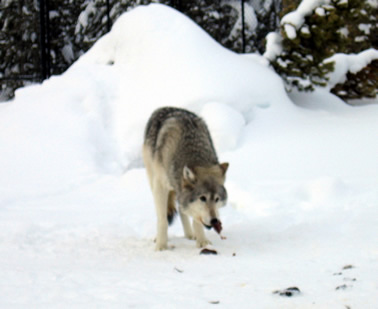 |
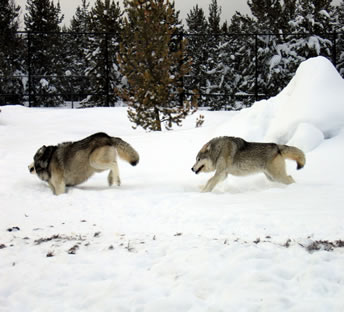 |
|
The Grizzly & Wolf Discovery Center in West Yellowstone
is a non-profit wildlife preserve & educational facility. It rescues
and studies animals who can no longer survive in the wild, including six
wolves. These wolves are fed daily, but don't always choose to eat as
is their custom in the wild. This one must be hungry. -Photo by
Steve Giordano.
|
These two wolves frolic in their Discovery Center habitat.
The wolves here have established their traditional pack ranking of Alpha
male and female and other subsequent rankings. -Photo by Steve
Giordano.
|
George Bumann, naturalist and sculptor who works as a guide and educator with the Yellowstone Forever Institute, greeted us. He handed out our boxed breakfasts, piled us into his van and proceeded to drive us in the dark along a snow-packed road to the Lamar Valley where wolves are known to howl and appear to those brave enough to brave the pre-dawn cold. Although we were visiting during the winter, guided tours and accessibility to the Valley for wolf sightings are year-round opportunities for visitors.
As we ate our oranges and yogurt, George shared a wealth of information. The Yellowstone Forever Institute, in partnership with the National Park Service, embraces a motto of "inspire, educate and preserve." The non-profit Institute offers over 400 courses, seminars and guided educational trips every year. They enjoy a "Lodging and Learning" partnership with Xanterra, Yellowstone National Park concessionaire, which operates lodging, restaurants, gift shops and activities in the park.
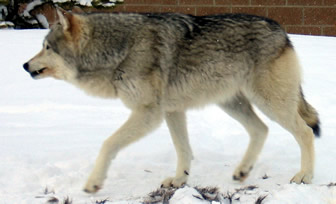 |
 |
| Each wolf at the Discovery Center has a name, a personality
and a biography which are all shared with visitors through guides and brochures.
-Photo by Steve Giordano. |
The Discovery Center encourages animal adoptions from visitors. For more information on their research and their educational programs, visit www.grizzlydiscoveryctr.org or email info@grizzlydiscoveryctr.org. -Photo by Steve Giordano. |
We stopped first at the Hell Roaring Overlook pullout where a researcher held up a GPS tracking device attempting to locate mountain lion movement that morning for their seven-year-long study. We looked and listened for wolves, but, finding none, moved on.
Our next sighting was an elk carcass beside the road with its entire skeletal spine bare and visible. It was covered in ravens. In corporate America territory, the mantra is "follow the money." In wolf country, if you want to find wolves, follow the ravens. They will signal a recent kill where they're picking the bones dry. Wolves cannot be far a field.
 |
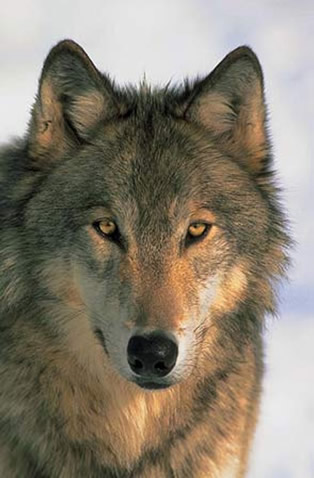 |
| In the misty early morning light, a research scientist holds up a GPS device continuing a daily study to track mountain lions in Yellowstone Park. This is part of a seven-year long behavior study of these cats. -Photo by Steve Giordano. | The wolf evokes many human reactions. As Barry Lopez,
author of "Of Wolves and Men" suggests, depending on our perspectives,
we each see the wolf in different shades of light. Consider the wolf from
these points of view: The Eskimo; The Native American; the scientist; the hunter-fur trader; the rancher; the tourist; the jounalist/photographer. We all see this magical animal through diverse points on the prism. -Photo by Xanterra Parks and Resorts. |
We next pulled off at a wide spot in the road with vast meadows of snow-covered vistas on either side. After clambering out of our warm coach, we stood quietly and listened. Listening is key. So is looking. Talking is not. Light was beginning to show.
Once we heard wolf cries and howls on both sides of the road, our guide George dug into the back of our van and came up with a multitude of spotting scopes. He sensed there were many wolves in the area and used his communication system to let others in the area know where we were and that this morning we had come upon the mother lode of wolf packs.
Slowly, many other "wolfies" (enthusiasts who follow the packs and share their experiences and knowledge with the Parks and the Institute) gathered at our pull out. They had no doubt heard the rumor that this was where the wolves were gathering this morning.
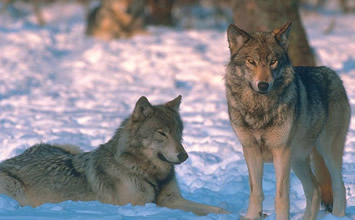 |
 |
|
Since the wolf reintroduction project of 1995 at Yellowstone, the
population has expanded to 160 or more. Each wolf has a number and an
identity. Wolf-observers, or as they're affectionately called - "wolfies"
- know each and every wolf, all their tribes, their position in their
tribes and their personalities. |
When the word goes out that wolves are spottable at a certain site, wolfies gather and pull out their spotting scopes to view wolf activity that may be as far as a mile away. By the way, that's our well-known and excellent naturalist guide, George Bumann, in his signature fedora. -Photo by Steve Giordano. |
We were so excited we chatted about what was pending. Rick MacIntyre, who had just driven up, (his moniker is "Wolfie #1") told us in no uncertain terms to "shut up" and listen so he/we could hear the howling.
Long story short - we saw and/or heard four wolf packs that morning. They howled, communicated with each other, stood their ground, their territories and even triangulated an elk, which is one of the food mainstays for wolves. (Bison is another.) Interesting factoid: a wolf's jaw has 1,500 lbs. per square inch of pressure and it can take down a large ungulate by the throat in no time.
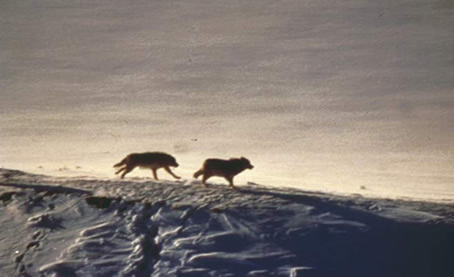 |
|
| Social animals as they are, wolves rarely travel alone. They stay with their own tribes and cover their own territory together. -Photo by Xanterra Parks and Resorts. |
An unsuspecting elk happened into a huge wolf pack and was slowly surrounded by them. The dynamics were fascinating. The elk never moved a muscle for at least an hour. The wolves, having taken down a kill the day before (according to our guide) were not especially hungry and just made the whole event into a dramatic standoff. Eventually, the elk and the wolves went their own ways.
The spotting scopes afforded a remarkable view of this soap opera which was taking place three-quarters of a mile away. The scopes took us right into this unforgettable drama that, in memory, would last a lifetime.
IF YOU GO
XANTERRA PACKAGES
Xanterra Parks and Resorts in Yellowstone offer winter as well as spring, summer
and fall packages. Just one of their many programs, Lodging and Learning includes:
Accommodations, Xanterra's Snow Card good for 10% off meals, in-park transportation,
tours, ski shop services and retail items. Lodging and Learning programs are
available year-round. Check www.TravelYellowstone.com
to make reservations and for more details.
For more information about the Yellowstone Forever Institute and their world-reknowned
educational programs, check www.yellowstone.org.
In West Yellowstone, The Grizzly and Wolf Discovery Center is just one sample
of the wildlife, local attractions, snowmobiling and x-country skiing/snowshoeing
opportunities in Montana's west entrance to Yellowstone National Park. For more
information about this rich Historic District and more: www.westyellowstonechamber.com